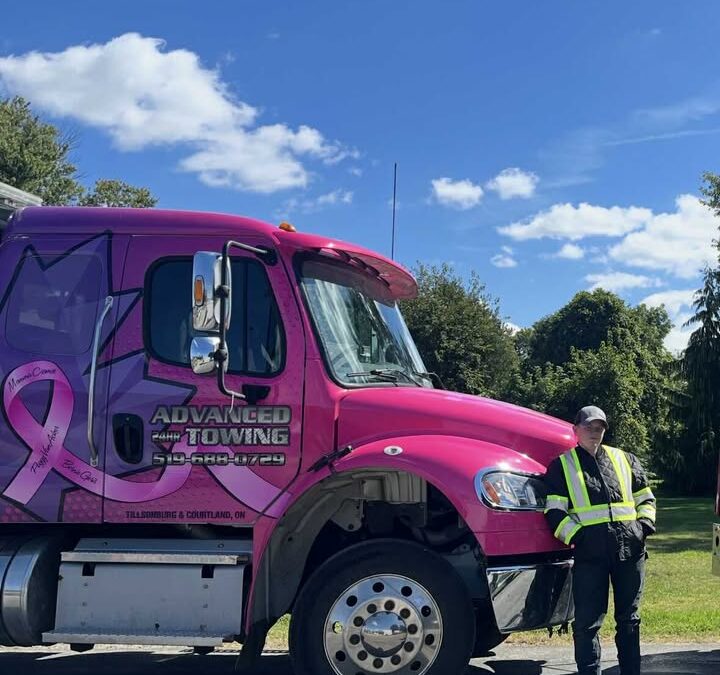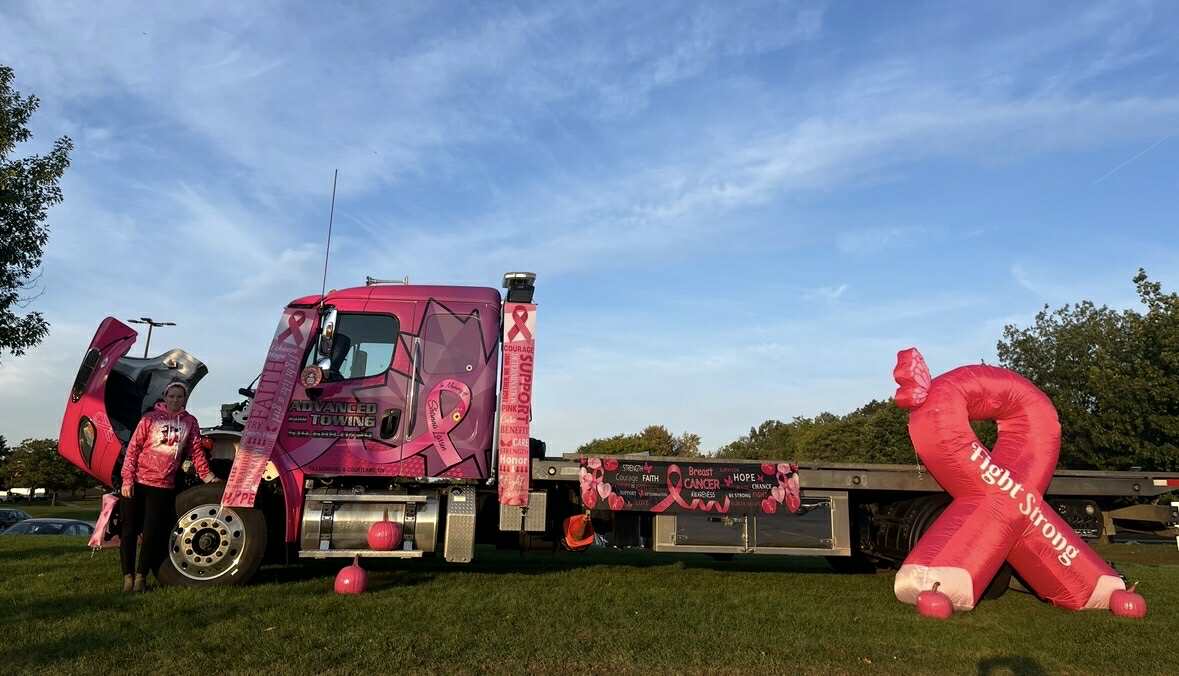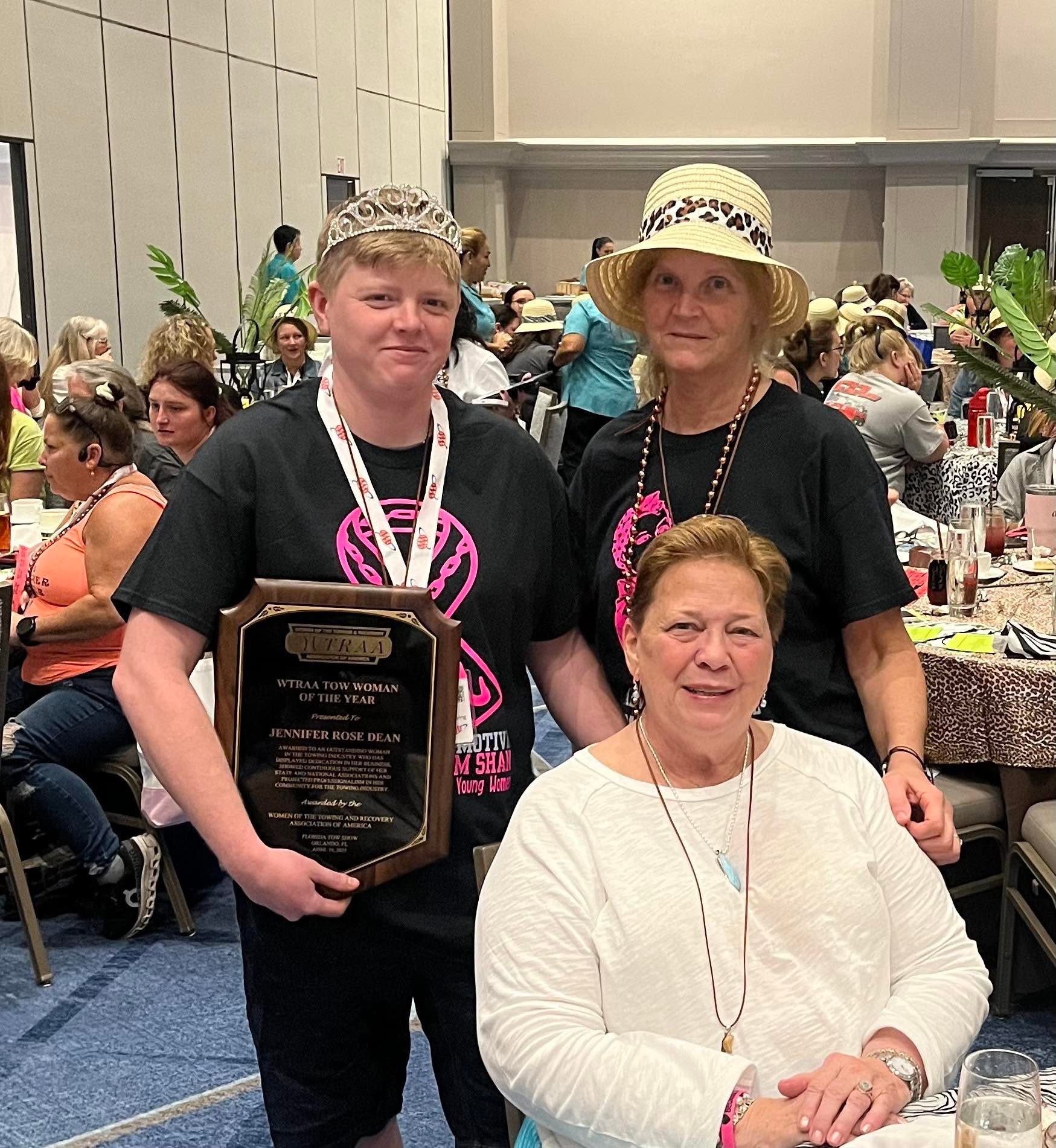


Jennifer Dean: A Trailblazer in Towing and Breast Cancer Awareness
Jennifer Dean has been behind the wheel of a tow truck since she was sixteen. Today, she pilots a 2023 pink Breast Cancer Awareness Freightliner M2, using her rig as a mobile billboard to spark conversations and bring hope to the roadside.
In 2023, Jennifer won the Hero of the Industry award at the PTAO Tow Show. That same year, the Oxford Ontario Provincial Police honored her for life-saving actions during a community event.
In 2022, Jennifer launched her own fundraising initiative for Team Shan Breast Cancer Awareness for Young Women.
• 2022: Raised $2,500
• 2023: Raised $2,000
• 2024: Raised $3,073
When she presents this year’s check, her solo total will top $10,000. She often channels her passion into demolition derbies, donating every penny of her winnings to the cause.

Every shift, Jennifer’s eye-catching pink truck serves as an icebreaker at recovery scenes. Customers and colleagues alike stop to offer compliments and share stories of loved ones affected by breast cancer.
Recently turned thirty, she continues to drive alongside her family in the towing business. Off-duty, Jennifer serves as a police auxiliary member, a military reservist, and was formerly a firefighter demonstrating her unwavering commitment to community service.
In November 2023, Jennifer’s journey appeared in Tow Times magazine. Her crowning achievement came in April 2025 at the Florida Tow Show, where she became both the first Canadian and the first international woman to receive the Women of the Towing and Recovery Association of America award.

It’s inspiring to witness women like Jennifer reshape the towing industry and empower one another.
Submitted by Rosemary Dean
Photo Gallery

How a Scholarship and Sisterhood Propelled Me into a New Career
I love my job! It all started 5 years ago and I haven’t looked back since. I finished my classes, passed all my exams, successfully got my Z endorsement, and finally on my first attempt, I passed my road test on August 18, 2020, obtaining my full AZ licence! None of that would have been possible for me if it wasn’t for a group of women who empower other women, supporting each other, educating one another, building all women up, cheering each other on to reach your potential, and giving opportunities to women who otherwise may not have them. We all have dreams, and those dreams become achievable for each of us when we support each other.
The day the Women’s Trucking Federation of Canada awarded me a scholarship is the day they changed my life and five years later, I find myself even more thankful than I was back then. I’ve worked hard to make them proud of their decision to support and believe in me and hope I have done just that. I’m 50 years old and a mom of 4 Kids who always came first, so my dreams were put on hold. Being a mother of 4 is a very hands on job but eventually, my kids grew up, became adults, and I decided to go after something I’ve always wanted, and the Women’s Trucking Federation of Canada was right there to support me. They are a huge part of my story, having helped me to achieve my dreams, and got me to where I am today. For that, I will forever be thankful.
I acquired employment immediately after passing my road test with Contrans Tank Group. Today I work for Contrans as a local driver out of our Burford terminal, pulling liquid tankers hauling a variety of food grade products. I pull both tandem and multi-axle equipment and even pull a trailer with my picture on the side of it. I love the days I get to pull that trailer! Throughout my career, I’ve faced some challenges, as everyone does when first starting out. Some of the hardest challenges are those simply associated with being a woman in this line of work. From the beginning, it’s been nothing I’ve been too afraid of to face head on or had any issues with showing what this woman is capable of. I’ve worked hard and come a long way in a short time, earning respect with male Drivers where so many times, it’s usually given automatically. I’ve been asked, why would I want to work in a profession that is historically male dominated? Why would I want to be a trucker, that’s a man’s job? I always respond with why not? I’m quite capable regardless of our differences. If nobody questions a male in a traditionally female-dominated career, why should a woman have to explain or justify herself?
Since day 1, Contrans has welcomed me as a part of their team. My dispatchers, the mechanics, the wash bay crew, management, and my fellow Drivers have all treated me with respect, and supported me through good days and bad and I am proud to work along side each of them. Working for Contrans has given me the opportunity to continue to learn and grow, not only as a Driver but also as a person. I have a lot more self-confidence now and I’ve certainly toughened up. When I was offered the opportunity to be a trainer for new hires (something I am very proud of), I was shocked to think, “Contrans believes in me?”. I now get to spend 2 weeks on road with new hires, training them on equipment use for loading & offloading product, customer sites, yard movement, safety & emergency procedures, paperwork, and anything else they may need to have a successful career driving for Contrans Tank Group. I really enjoy this part of my job and it means a lot to me that Contrans trusts me to be one of their trainers.
I find myself sitting back and thinking, “Wow 5 years went by fast and so many things have changed for me”. The best change of all is that I don’t dread going to work anymore because I get to do something I love every day, and every day is a new adventure! Thank you to everyone at The Women’s Trucking Federation of Canada for helping me achieve something I had wanted for such a long time. I do not take the opportunity you gave me for granted at all and I recognize, appreciate, and value what you have done for me. Your generous gift unlocked my success story and I will forever be thankful!
Dana Allard is a Professional Driver at Contrans Tank Group
A Message from the Women’s Trucking Federation
Dana,
We couldn’t be more proud of everything you’ve achieved over these past five years. From the moment you earned our scholarship to the day you passed your AZ road test on the first try, you’ve exemplified determination, passion, and excellence in every mile you’ve driven.
Your rapid rise from new driver to trusted trainer speaks volumes about your skill, leadership, and unwavering commitment to safety and professionalism. You’ve not only shattered stereotypes in a traditionally male field, but you’ve also become a role model for women across the industry showing what’s possible when dreams meet hard work and support.
Watching you mentor new hires, guide them through every procedure, and empower them with confidence fills us with immense pride. Your success story is exactly why we exist: to open doors, foster sisterhood, and amplify women’s voices on and off the road.
Thank you for carrying our mission with such grace and grit. We look forward to cheering you on as you continue to blaze trails, inspire others, and redefine what it means to be a woman in trucking.
In sisterhood and solidarity,
The Women’s Trucking Federation of Canada Team
Resources and Advice for Aspiring Women Drivers :
• Join a women-focused industry network for mentorship and support
• Partner with a company/trainer who believes in you and challenges you to grow
• Build confidence through continuous learning “every mile is a lesson”
Keep your dreams alive, support one another, and remember: the open road is big enough for all of us.

Labour Trafficking in Canada’s Trucking Industry: A Call to Action
On International Human Trafficking Day, we shine a light on one of Canada’s most hidden crimes labour trafficking within our trucking sector. Drivers from around the world arrive promising to work hard and build a future, only to find themselves trapped in debt bondage, unpaid overtime, and threats of deportation if they speak up.
The Scope of the Problem
In Manitoba, trucking employers hired 1,467 temporary foreign workers in 2023 a surge of nearly 1,300 percent from five years earlier while training and reporting measures for these vulnerable employees remain critically lacking.
A United Nations Human Rights Council report highlights how Canada’s LMIA process can be exploited by recruiters, training schools, temp agencies, and carriers working in concert. Drivers often incur debts of $40,000–$80,000 in recruitment fees and then endure sub-legal wages and withheld pay to service that debt.
How You Can Help
– Educate your drivers and dispatchers on the red flags: isolation from peers, withheld passports or work documents, unexplained debt and contract changes, and threats of deportation.
– Partner with organizations like Know Human Trafficking, Crime Stoppers and local law enforcement to install posters and helpline information at terminals, rest stops, and training schools.
– Encourage all drivers and dispatchers to complete free training through Know Human Trafficking to recognize and respond to labour trafficking indicators.
– Advocate for stricter enforcement of labour standards by urging provincial authorities to suspend carriers found guilty of wage theft, worker misclassification, or trafficking offences.
Resources & Reporting
– Call the Canadian Human Trafficking Hotline: 1-833-900-1010
– Contact your provincial employment standards branch to report wage theft or forced labour
– Reach out to Know Human Trafficking for support and training materials
Together, we can ensure every individual on Canada’s roads works under fair conditions with dignity, legal protections, and the freedom they deserve.
Top 5 Signs of Labour Trafficking in the Trucking Industry in Canada
1. Confiscation or withholding of identification documents
Victims are often forced to hand over passports, driver’s licences or work permits, with employers claiming they “need” them for processing or to ensure compliance. This tactic leaves workers without proof of legal status and makes it nearly impossible to leave or seek help.
2. Excessive recruitment fees or deceptive job offers
Labour traffickers advertise trucking jobs that promise high pay, then require migrants to pay thousands sometimes tens of thousands of dollars in recruitment or “head tax” fees. Such offers turn out to be bait-and-switch schemes, leaving workers indebted and trapped in exploitative contracts.
3. Threats of deportation, retaliation or reporting to authorities
Employers exploit the precarious immigration status of temporary foreign workers by threatening to report them to immigration or police if they complain, attempt to leave or demand fair treatment. Fear of losing their right to remain in Canada silences many victims.
4. Wage theft, withheld pay or unpaid overtime
Common tactics include withholding paychecks, underpaying hourly rates, refusing overtime compensation and imposing arbitrary fines for minor infractions. Workers discover they’re earning far less than agreed, but risk reprisal if they challenge the abuse.
5. Unreasonable work hours, unsafe conditions and isolation
Trafficked drivers often endure excessive hours behind the wheel without mandated breaks, live in company-controlled accommodations with poor hygiene or safety standards, and have little to no contact with the outside world. These conditions endanger both their physical health and legal well-being.

Ontario’s Roadway Crisis: Summer 2025 Wake-Up Call
Ontario’s Roadway Crisis: Summer 2025 Wake-Up Call
Ontario’s roads have claimed too many lives this summer. Across the province, a recent two-week surge of deadly collisions, motorcycle tragedies, head-on crashes on our busiest highways, and at-fault truck incidents paints a grim and urgent picture.
You never know whose life you’ll change with a single glance. Last summer, paramedic Alisha raced against the clock to save a motorcyclist pinned beneath a pickup truck. She arrived to find him conscious but slipping fast every second mattered. Stories like this unfold on our highways daily, reminding us that speed, distraction, or one missed look can shatter families in an instant.
It’s time for a new kind of road pact one where each of us pledges to act before the crash happens. When you commit to that extra “second look,” you’re more than a driver; you’re someone’s guardian angel.
Fatalities by the Numbers
In 2023, Ontario recorded 812 road-user fatalities, a 6 % rise over 2022.
- Pedestrians accounted for 35 % of those losses.
- Bicyclists and motorcyclists made up 18 %.
- Impaired-driving collisions rose by 4 %.
- Speed-related crashes climbed by 7 %.
What’s Driving the Carnage?
- Speeding and aggressive driving
- Impairment from alcohol, cannabis, or prescription drugs
- Distracted driving: phones, navigation, in-car tech
- Rider inexperience and fatigue
When these factors converge, the outcomes are catastrophic.
Two-Week Surge: July 11–24, 2025
- July 16: Head-on collision on Highway 7 near Pickering 3 killed, 2 critically injured
- July 11–19: Five separate motorcycle crashes across Kawartha Lakes, Thunder Bay, Niagara, London, and Leamington multiple fatalities and critical airlifts
- OPP officer struck by a fleeing vehicle during an impaired driving stop
- Deadly collisions on rural backroads and 400-series routes alike
Take the Pledge
Share this pledge with family, friends, and colleagues. Use #DriveLikeTheyMatter
Before every trip, I will:
- Obey posted speed limits
- Designate a sober driver or choose alternate transportation
- Stow my phone until I’m parked
- Give large trucks ample space
- Always take a second look for motorcycles and pedestrians
- Check blind spots and intersections before turning
I’m asking you to see these roads not as endless asphalt, but as mirrors of our choices every time we drive. When we pair sobering statistics with real stories and commit to simple, lifesaving actions we can stop these heartbreaking losses. Please share this message: someone’s life may depend on it.
Resources:
- Ontario Road Safety – CAA South Central Ontario
- Transportation Safety | Ontario.ca
- Road Safety | Public Health Ontario
- Road Safety in Canada | Transport Canada
- Canada’s Road Safety Strategy 2025 | CCMTA
Photo Credit :
At the Scene Photography
https://atthescene.wixsite.com/atthescene
Email: atthescenephoto@gmail.com









